Why is there such a push for personalized selling these days?
Adding a personalized touch to your selling puts your leads and customers at the center of everything. It makes your prospects feel unique, understood, and valued. It also makes them more open to hearing your pitches and offers.
Think about it this way:
You only have a handful of best friends. They probably never ignore your calls or texts because they’re excited to hear from you, and they trust your helpful advice because you understand their background and goals.
That’s what personalized selling can do for your customer relationships.
Selling doesn’t have to be a numbers game. You can sell to fewer people with more success if you take the time to personalize your messaging and learn who you’re actually selling to.
So in this article, we’ll go over the best ways to make your selling feel more personalized.
7 Ways To Personalize Your Selling
Is it really worth your time to personalize your selling? According to data collected by Forbes:
- 84% of consumers say being treated like a person, not a number, is very important to winning their business.
- 80% of consumers are more likely to buy from a brand that provides personalized experiences.
- 89% of digital businesses are investing in personalization, with 51% of marketers ranking personalization as their top priority.
- Personalization can reduce customer acquisition costs by up to 50% and increase marketing spend efficiency by up to 30%.
See why it’s worth the extra effort?
Personalized selling makes all the difference in whether your leads interact and engage with your messages or ignore them. It can help you build trust and deepen customer relationships. And this type of engagement almost always leads to more sales.
So try these seven ways to make your selling feel more personalized today:
1. Get better at writing emails
Every marketer wants to write killer emails that break through crowded inboxes. To personalize your approach with leads and customers:
Use their name/business name in the subject line. It’s not just that personalized emails always yield a higher open rate, but the science tells us that people are more attentive when they hear/see their name. So adding a name to a subject line increases the odds of your emails being read and your offer being considered.
*Change your email content based on audience segmentation, buyer personas, or specific triggers *(such as a product purchase, survey response, customer support ticket, etc.).

Use your customer data to group leads and customers into specific categories. You could base these on their purchase history, browsing activity, and next steps. Or you could organize them by demographics (like age or location).
Email marketing automation allows you to craft personalized, relevant content for the right people at the right time. This content should pique their interest, contain offers that resonate with their needs, and give them a nudge to take action.
Maybe that’s why marketers report a 760% increase in email revenue from personalized and segmented campaigns.
Add relevant calls to action (CTAs). Personalized calls to action convert 202% better than default or standard CTAs. Just switching the phrasing from “click here” to “book a consultation” can get the conversation started or spur your reader to make a move.
Reward your loyal customers. Besides thanking your customers, you can also take the chance to upsell or cross-sell complementary products/services. Sweeten the pot with a special discount code, free demo, loyalty badge, or other incentives. If you have the budget, customer loyalty software is a great way to automatically track and strengthen customer loyalty after the point of purchase.
Take these steps, and your recipients will be excited and eager when your emails arrive. And they may never send them to the trash, or worse, mark them as spam.
2. Understand your buyers’ motivation
People buy products that will help them solve a problem, earn more money, or make them look good to their bosses. When you take the time to learn and understand their needs and goals, you can personalize your sales and have better conversations.
According to data from Salesforce, 84% of consumers believe a company’s understanding of their needs influences their decision to buy.
One way to understand buyer’s motivations is to integrate your customer communications tools with your CRM.
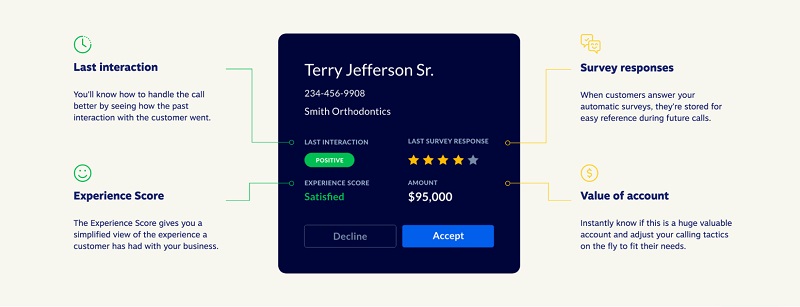
UCaaS features like Call Pop (seen above) integrate with your CRM to track each touchpoint customers have had with your brand. You can store past interactions, customer experience scores, survey responses, and more.
Seeing this intel as soon as the call comes in gives you a head’s up on how to handle it. Then you won’t have to wrack your brain to remember every customer to personalize their experience. The software does all the heavy lifting and allows your reps to personalize their conversations.
Quiz: See how ready you are to upgrade your communications platform
3. Make it about their business, not yours
When you understand what motivates your buyers, you can personalize your pitches. In fact, 70% of consumers say that a company understanding how they use products and services is very important to winning their business.
So grab as much information from your leads as possible in the discovery call phase of the conversation. Outline their pain points, current processes, and budget, for example. Then narrow down the best solutions for them.
What do they stand to gain or achieve by choosing your product/service? Will they save time and boost productivity? Achieve a higher ROI? Below is an example of a personalized, thorough sales email showing the value in the pitch:

Skip the generic pitch and lead with these potential wins. Show them exactly how your solution will solve their issue as if you were recommending the product to a friend. They’ll be more likely to trust your advice when they see what’s in it for them.
4. Always be prompt, courteous, and informative
Part of personalized selling is making your prospects and customers feel like they’re your number one priority. To deliver that white-glove sales experience, make sure to:
Promptly respond to questions and requests. You don’t have to answer calls at all hours of the night. But you do have to respond in a timely manner when leads or customers have questions, concerns, or problems.
Never let communication go ignored or unanswered for more than 24 hours. If you need more time to find an answer, reply that you’re working hard on a resolution and follow up shortly after. Even if you’re getting no response after no response, be courteous in your outreach. See the example below from Sales Hacker:
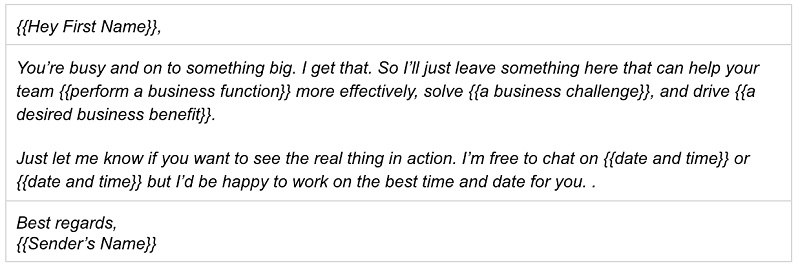
Never be late to phone or video meetings. Showing that you respect others’ time is essential for friendships and customer relationships. Test your phone, audio, and video settings to ensure you’re ready to go at least 10 minutes before your meeting begins.
You can take this courtesy a step further by sending the other person a brief meeting itinerary ahead of time. Outline your main talking points to excite them about what you have in store.
5. Have a knowledge base available
Deferring frequently asked questions (FAQs) to a knowledge base doesn’t show a lack of personalization. It’s a great tool to free up time for both you and your leads/customers.
Stats demonstrate that people turn to self-service options first before reaching out to customer support or a salesperson (Social Media Today):
- 70% of customers prefer to use a company’s website to get answers rather than phone or email.
- 91% of customers would use an online knowledge base if available and tailored to their needs.
A user-friendly and well-organized knowledge base provides your audience with access to answers on their time. They can find instructions, user manuals, walkthroughs, infographics, blog posts, etc., all on their own.?? Below is an example of how MailChimp structures they’re easy to use knowledge base for customers:
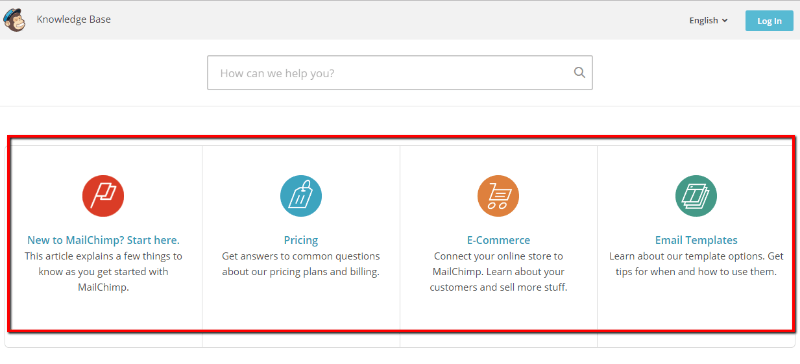
To personalize the experience, keep your knowledge base updated. Research relevant keywords to see what your customers are looking for. And optimize your content for their needs. Bonus points if you can analyze these interactions to expand your customer data insight.
The unification of customer data in a sprawling digital ecosystem is also a key goal of customer data platforms and when it comes to building a Customer 360 framework by incorporating data from all sources into one centralized location, they represent the best option
6. Don’t stop after the sale
To avoid having your customers feel like “just another number,” check in with them routinely, but not to the point where it feels like you’re heckling them.
See how they’re doing with your product or service. Discuss what they’re liking or disliking about it. Talk about features they use most/least. Ask if there’s anything you can do to help or if they have suggestions. Below is a brief email template of how to approach current customers in a helpful but concise manner.
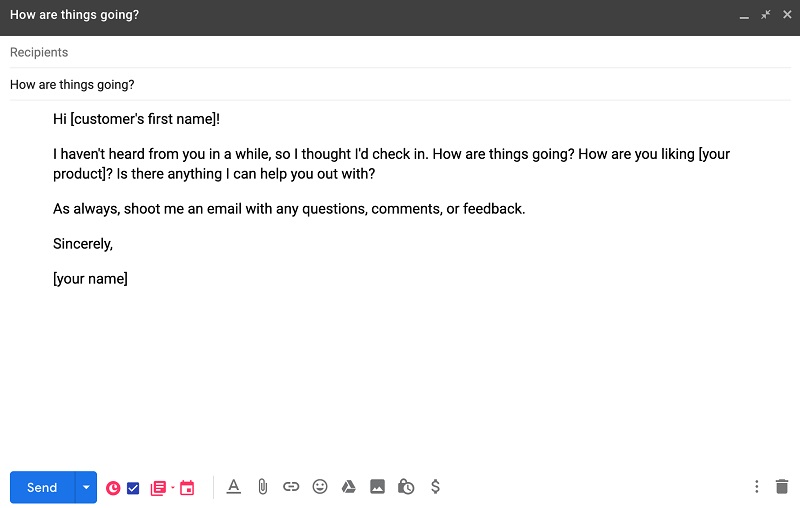
Check-in during key career milestones. Did one of your customers just earn a promotion? Did a warm lead close a recent round of funding? Congratulate and support them!
When people see you’re genuinely in their corner and want them to succeed, they’ll know you’re not just trying to sell them something.
Remember, this isn’t the time to close deals. Focus on deepening relationships, so when your contact is ready to buy, you’re the first one they call.
Engage on a personal level. Send emails on birthdays, holidays, when they’re featured in an article, write an interesting post on LinkedIn, and more.
People are more likely to buy from brands when they feel valued and appreciated by them. And a staggering 73% of consumers say a business has never communicated with them online in a way that felt too personalized or invasive.
People like the surprise of this authentic communication. They get excited to open your emails because they won’t always be a sales pitch. This is how you network and build one-on-one relationships that last for years.
7. Ask for feedback
Even if you lost out on a sale to a competitor, don’t be scared to ask your prospects for feedback. Be open to hearing their take and acting on reasonable suggestions.
You can send out an automated survey with multiple-choice or open-ended questions, such as:
- How did you evaluate all possible solutions?
- What features does our product/service lack?
- What was the main selling point of the solution you chose?
- What did you find most useful about our product/service?
- Did the price seem fair/too high?
- Is there anything I could have done to close the deal?
Below is an example of an honest customer retention sales survey from Hotjar. Just a few of these questions could give you the feedback you need to hear:
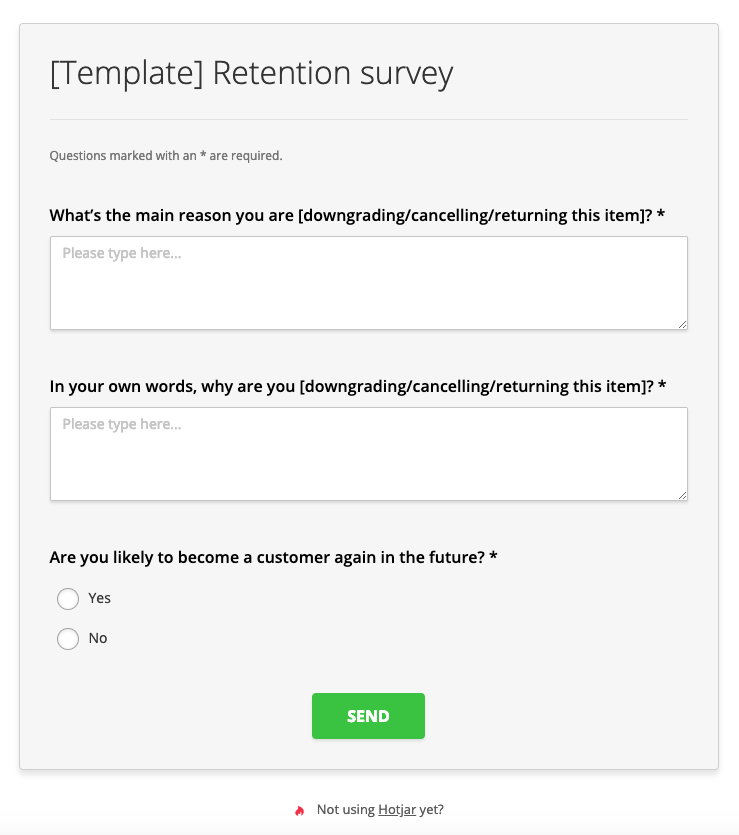
Asking for feedback only benefits you and shows the customer you care. They may decide your competitor’s product ultimately didn’t fit their needs. And this final interaction they have with you may encourage them to come back, especially if you implement some of their ideas.
Related Content
- 12 Best Email Marketing Tips for Entrepreneurs
- How to Sell on Shopify: 7 Easy Steps to Sell Your Products Like a Pro
- 30 eCommerce Marketing Strategy Examples with Proven Success
- How Top Businesses Follow-up With New Leads: 281 Top SaaS Companies
- Strategies to Handle Negative Posts and Feedback
Personalization wins every time
Personalized selling will take your customer relationships, engagement, and conversions to the next level, but personalization is much easier said than done and takes lots of repetition and practice to get it right.
Start by getting better at writing emails you feel more confident sending. You can practice with teammates on your sales team or pull inspiration from sales email templates.
Study your buyers’ motivation. This may take some collaboration with marketing and your customer success team. Knowing “why” your buyers choose your business over competitors gives you a selling advantage. Knowing what their pain points are will make your conversations more tactical and productive.
Remember to make your selling about their business, not yours. A prospect won’t care about your latest product launch if they don’t understand how it helps them and their business.
Being courteous, prompt, and informative in your outreach will have prospects feel they are your top priority. And you’re not sure about a way to answer their questions, resort to an internal knowledge base. While you’re at it, ask for feedback and relay that to your marketing and customer success teams.
Don’t stop after the sale and be consultative. This shows your customers that you care about their success. Personalization is worth the squeeze. Companies using advanced personalization strategies report a $20 return for every $1 spent, and you could score similar results if you put today’s tips into practice.

Written by our guest writer Devin Pickell, a Growth Marketer at Nextiva
He combines his skills in content marketing, SEO, data analysis, and marketing strategy to meet audiences at the right moment in their journey. He has helped scale SaaS brands like G2 and Sphere Software and contributed to G2’s traffic growth of more than 1 million visitors per month.



